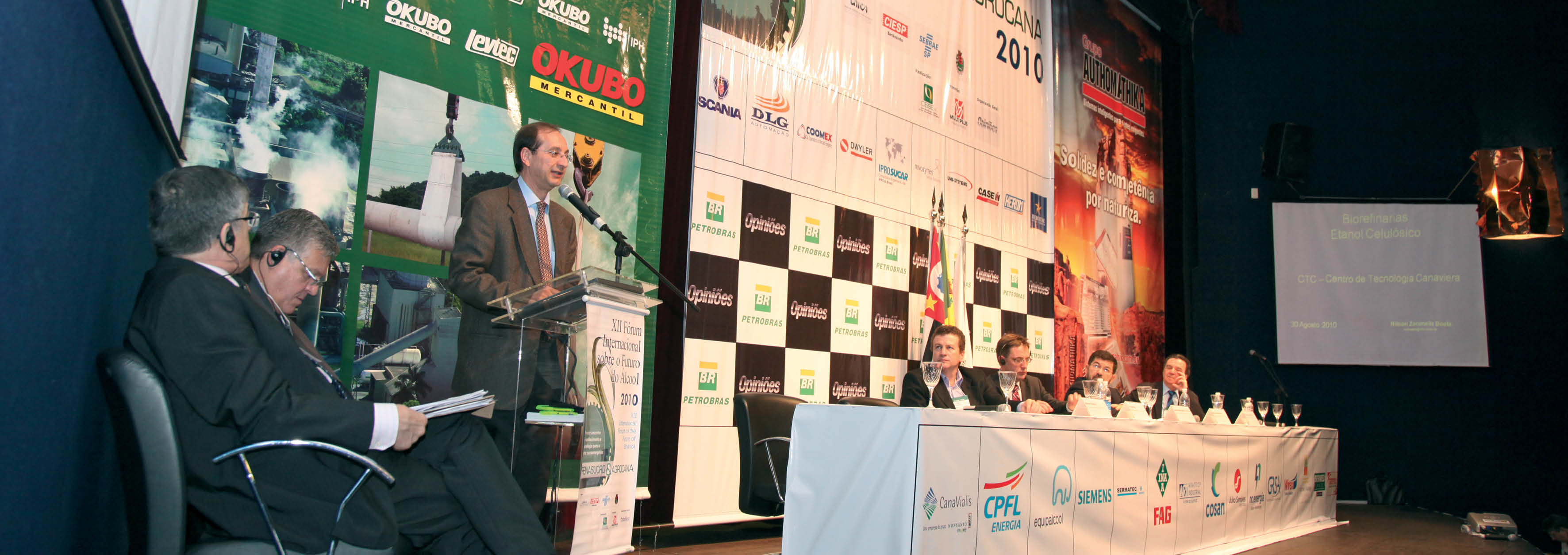Nilson Zaramella Boeta
Superintendent of CTC -(Sugarcane Plantation Technology Center)
Op-AA-26
We are only just beginning
When one talks about biorefineries, one is in fact talking about switching a number of products that nowadays are obtained from oil, to products originated from renewable sources. This means being competitive in light of a well established and highly efficient industry – the oil industry, refineries and the chemical industry in general. One may initially perhaps rely on subsidies and policies, however, over time, one will need to be efficient, competitive and advantageous in relation to the environment, trade, industry and consumers of such products.
We have a large volume of bagasse available. However, on this new frontier researched by the CTC, straw enhances biomass’ potential even more. As related to varieties, we are studying not only the high efficiency sugarcanes of South Central Brazil, but mainly the regional canes. The CTC set up centers on all sugarcane frontiers in the country.
We count on 140 associated mills that resort to these regional centers under a cooperation program. We test our cane in practically 98% of Brazil’s soils and climates, thus allowing identifying the superior cane in each unit. Nowadays, we have 7 million hectares of sugarcane plantations, 60% of whose volume is processed by CTC associates. When a soil map of an endaphoclimatic environment is available, one can identify the best variety for that region.
The wrong variety can result in lower productivity of up to 25%. Other factors to take into consideration are rainfall, pests, and diseases in the region.We have already concluded the mapping of 2 million hectares, mill after mill, plot after plot. Our intent is to map all soils and climates at all our associates by 2013. Among the main characteristics we look for in sugarcane, the first is resistance to insects.
Conventional improvement results in average productivity gains of 2% per year. This is a good result, however, we will need to use other resources to achieve significant growth in productivity. One is transgenesis, a subject matter we are studying together with several important partners around the world. In searching for a variety resistant to insects, we went looking for the best partner anywhere in the world – Dow Agrosciences.
We have already achieved lab results and conducted field tests. The solution for this issue will be an actual increase in productivity. Relative to tolerance to drought, with BASF we developed another partnership, seeking to minimize damage and achieve faster regeneration of a sugarcane plantation if such incident occurs. Another interesting partnership is with Bayer, which has gens that allow sugarcane to accumulate more saccharose and other sugars.
We are looking for cane that provides up to 25% more saccharose in comparison to current varieties. All these partnerships are with leading companies in the world market, in which the CTC contributes its know-how and its genoplasm, while they bring in their gens in a technological package, seeking to achieve superior performance. Possibly in three years we will have the first transgenic sugarcanes ready for certification, to enter the market in five to ten years.
Nowadays, we are researching sugarcane that accumulates saccharose and biomass at the beginning and the end of the harvest, looking for a better balance throughout the harvesting period. To that end, we use molecular markers, which are part of the DNA in which one identifies the performance characteristics, knowing if the sugarcane will stand tall, if it will accumulate sugar, grow more roots, have more leaves, more fiber, in short, by understanding how the markers work, one is able to orient the crossbreeding, accelerate the entire process, thereby reducing the time needed to improve a new sugarcane variety from currently ten years to around five years, in what is an impressive productivity gain in accelerating the entry of such superior sugarcane varieties in the market.
As a route toward maximizing the use of biomass, the progress made in the mechanization of planting and harvesting consolidates significant gains. Regarding straw, if one were capable of harvesting half the volume efficiently from the cost point of view of mills, it would be like setting up a new Itaipu hydroelectric plant. There is an enormous amount of energy wasted by incineration.
Straw can be transported in a variety of different combinations: together with sugarcane or leaving it in the field to pick it up later, or a mix of the two methods. One must assess the various possible combinations of harvesting, loading and transporting the straw. We have operated a partnership with Fiat and New Holland for almost a year and by the end of 2011, plan to achieve initial results in making this process feasible.
Biomass has an increasingly more competitive price, bringing about a very interesting scenario for the mills. Most mills that have biomass availability are going the conventional route, because this is what is allowing economic returns and corresponds to the currently available technology. The CTC is participating in a consortium to attempt going the route of biomass gasification, that may generate more electricity than conventional methods, but it is a technology that may take 10 or 15 years to become competitive.
Relative to the hydrolysis of biomass, second generation ethanol is on a nearer horizon. We have progressed considerably and wish to share the enthusiasm concerning the results. To simplify the equation, when we break biomass down into basic components, we come up with lignin, and the C5 and C6 sugars. Lignin is high caloric charcoal. The C6 sugar is what one ferments in conventional yeast, a highly developed process.
C5 sugars are currently not fermentable, so this is the technology everyone is looking for.The challenge of enzymatic hydrolysis is to come up with efficient cellulose. First, when preparing the raw material, bagasse and straw, so that they can easily be digested by the enzyme. We also need high efficiency enzymes – a responsibility that lies with our partner in this project – Novozymes – which has cooperated in an extraordinary manner, reducing enzyme costs and increasing their conversion efficiency.
The pentose fermentation strains will take a little longer to be efficient and low cost, but this may be accomplished in the next phase. The project seeks to adapt all existing resources in the mills, using infrastructure, logistics, and the availability of raw material. Important in the end is that one is competitive in terms of cost, while upholding sustainability.It is important to point out that the new process will not prevent biomass from being used in its current application. What it will accomplish is to “lend” this biomass to separate the components.
Lignin, after being separated, will be concentrated and returned to the boilers, to be incinerated at a higher energy level than if it were burnt in its natural state. One will take the hydrolyzed sugars from the hexoses, run the usual process using the yeast one has today and then separate the C5 from vinhasse. One need not reinvent the wheel. It is possible to make adaptations and generate 30% more ethanol, even today, as compared with the current process.
When we began in 2007, the cost was eight times higher than that of conventional ethanol. We are coming to the end of the year, at a level of twice the cost. We learned a lot in these three years, like how to efficiently cook this biomass, extract lignin, and effectively separate C5 and C6. At the end of 2012, we will have a demo plant and in 2014 we expect to attain second generation ethanol costs coherent with those of the first generation, with no subsidies, benefits or protection.
In the extractive fermentation process, the CTC is developing, at a pilot plant in Piracicaba, and given that ethanol will be produced in a closed circuit, a plan of extraction that will not overburden the yeast that converts these sugars to ethanol. One would thus have less vinhasse in the process, reducing the relation from 12 to 4 liters of vinhasse for each liter of ethanol produced.
We are barely beginning to reach the potential to be found in sugarcane. Biorefineries, today, are already reality, and sugar, ethanol, electricity, and green plastics are already available, but the potential is only at a starting point. We can only see the tip of the iceberg; we are in the kindergarten phase of this technology. Society will be proud of this industry, given its efficient and renewable raw materials, replacing various products currently generated in processes that burn carbon.





